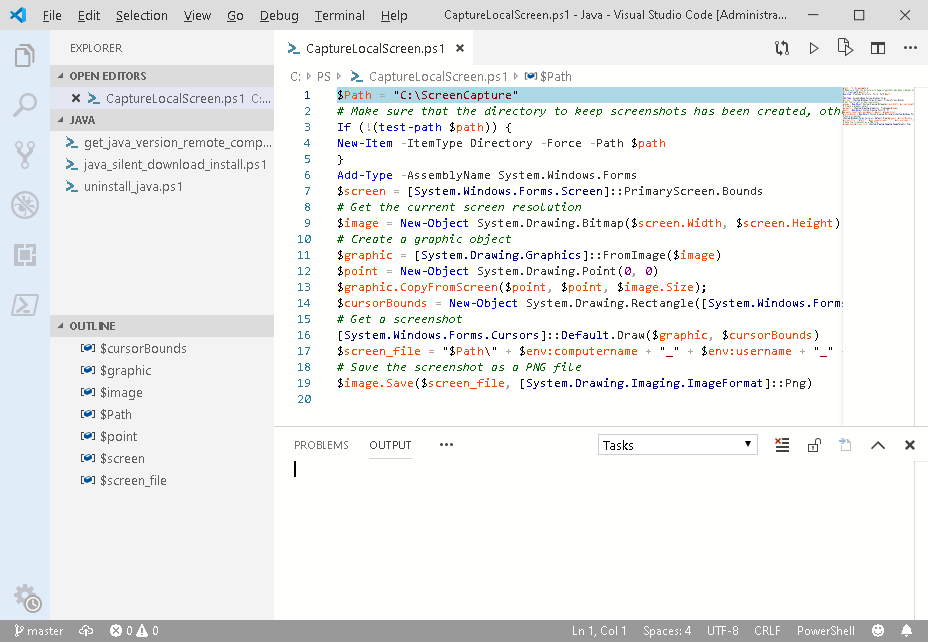A HelpDesk support team asked me to write a PowerShell script to quickly get a screenshot of a user desktop from a remote computer. The main condition is that the HelpDesk employee should not connect to the user’s computer through graphical remote support tools (SCCM, Remote Assistance, Remote Desktop Session Shadowing, etc.).
Capturing Screenshots Using PowerShell
First of all, let’s learn how to take a screenshot on a local computer with PowerShell. To capture a current desktop image, you can use the built-in .NET class System.Windows.Forms. I got this PowerShell script:
$Path = "C:\ScreenCapture"
# Make sure that the directory to keep screenshots has been created, otherwise create it
If (!(test-path $path)) {
New-Item -ItemType Directory -Force -Path $path
}
Add-Type -AssemblyName System.Windows.Forms
$screen = [System.Windows.Forms.Screen]::PrimaryScreen.Bounds
# Get the current screen resolution
$image = New-Object System.Drawing.Bitmap($screen.Width, $screen.Height)
# Create a graphic object
$graphic = [System.Drawing.Graphics]::FromImage($image)
$point = New-Object System.Drawing.Point(0, 0)
$graphic.CopyFromScreen($point, $point, $image.Size);
$cursorBounds = New-Object System.Drawing.Rectangle([System.Windows.Forms.Cursor]::Position, [System.Windows.Forms.Cursor]::Current.Size)
# Get a screenshot
[System.Windows.Forms.Cursors]::Default.Draw($graphic, $cursorBounds)
$screen_file = "$Path\" + $env:computername + "_" + $env:username + "_" + "$((get-date).tostring('yyyy.MM.dd-HH.mm.ss')).png"
# Save the screenshot as a PNG file
$image.Save($screen_file, [System.Drawing.Imaging.ImageFormat]::Png)
This PowerShell script creates a directory to store screenshots, gets the current screen resolution, captures an image of the current workspace and saves it as a PNG file. Run the PowerShell script and check that a png file appears in the specified directory (you can specify the UNC path to the shared network folder) with a screenshot of your desktop. For convenience, the name of the PNG file contains a computer name, a user name, a current date and time.
If you want to call the PS script from a batch file, use this command (in this case, you don’t need to change the PowerShell Execution Policy settings):
powershell.exe -executionpolicy bypass -file c:\ps\CaptureLocalScreen.ps1
You can create a GPO to place a shortcut for the PowerShell script on the desktops of all domain users and assign hot keys to call it. Now, when a problem or error appears in any app, a user can just press the assigned hot keys. Then a user desktop screenshot appears in the HelpDesk shared folder.
How to Take a Desktop Screenshot from a Remote Computer Using PowerShell?
The next task is to get a screenshot of the user’s desktop on the remote computer via PowerShell. It may be either a standalone computer running Windows 10 or an RDS server.
If you want to get a desktop screenshot from an RDS server (or a desktop Windows, in which multiple concurrent RDP connections are allowed), you must first get a user session ID on the remote computer. Specify the name of a remote computer/server and a user account in the following PowerShell script:
$ComputerName = "nld-rds1"
$RDUserName = "h.jansen"
$quser = (((query user /server:$ComputerName) -replace '^>', '') -replace '\s{2,}', ',' | ConvertFrom-Csv)
$usersess=$quser | where {$_.USERNAME -like $RDUserName -and $_.STATE -eq "Active"}
$usersessID=$usersess.ID
$usersessID = 1.To make it more convenient, save the PowerShell script file to a shared network folder. Then edit the CaptureLocalScreen.ps1 file and change the path to:
$Path = \\nld-fs01\Screen\Log
User screenshots will be saved to this folder. Grant write permissions to the folder for the Authenticated Users domain group.
After you have got a user session ID, you can connect to the user session remotely using PsExec tool and run the script:
.\PsExec.exe -s -i $usersessID \\$ComputerName powershell.exe -executionpolicy bypass -WindowStyle Hidden -file "\\nld-fs01\Screen\CaptureLocalScreen.ps1"
Then a HelpDesk team member can run the script from his computer, and a screenshot of the current desktop of the remote computer will appear in the specified directory.

4 comments
the script is really hellpfull
This captures the entire screen. Is there way to capture only a application window.
Requirements
1. Need to capture only a specific program window that is open.
2. What if there are multiple screens to the computer.
Thank you for sharing this useful script.
My problem is that taken screenshot is not correct (not full screen shown) if in display settings “Scale” set to 125%.
Please suggest solution.
Thank you
Works great from the command line.
I am invoking from the windows task scheduler via a bat file and the image captured is clear having no information. Any clue